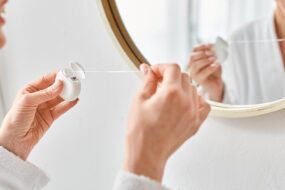The new DIY test making cervical cancer screening easier
Move aside, speculum – cervical screenings are about to become a whole lot friendlier thanks to a new self-collection test.
A new self-collection kit is being be offered as a less invasive alternative to a pap smear for cervical screening.
Starting July 1, 2022, it’s good news for early cancer detection and better news for those who find the whole speculum experience a bit daunting as this equally effective collection method allows you to collect a sample yourself.
The importance of cervical screenings
Cervical screenings are about catching cancer early, detecting what the World Health Organisation says is the fourth most common cancer in women.
This is why Australia’s National Cervical Screening Program (NCSP) recommends women and people with a cervix aged 25 to 74 get tested every five years.
In Australia, government stats have shown those diagnosed through the NCSP are 87 per cent less likely to die from cervical cancer, compared with Australians diagnosed in other ways.
Despite these clear benefits and free NCSP testing, Pathology Awareness Australia Ambassador Professor Marion Saville says not enough people are getting tested.
“Seven out of 10 people developing cancer in Australia are either unscreened or significantly overdue for screening,” Prof Saville says.
“Women, especially between the ages of 25 and 29, are not participating in the screening program in the numbers we would like to see. However, it’s important to encourage all women, especially younger women, to participate, as they are not completely immune from the disease with the HPV vaccination they received in high school,”
In late 2022, eligible women 25 to 74 will start to receive notification reminders from NCSP to book their five-yearly HPV test, which can be taken using the self-collecting method.
- Get tested: How screening can prevent most cervical cancers
What does self-collection involve?
Women can either self-collect or have a health professional collect a sample for them.
“Most people will still attend their GP or nurse to access the cervical screening test, maintaining the important relationship with their trusted healthcare provider,” Prof Saville says.
“There will now be an option to self-collect a sample from the vagina with a swab, as an alternative to speculum examination.”
Self-collection is not a new idea, however has been limited to a small eligibility pool.
Namely, people over 30 who had never before tested, or were at least two years overdue for a cervical screening.
Each screening requires a cell sample, which tests for human papillomavirus (HPV).
“Participating in regular cervical screenings is so important as we know that almost all cervical cancer is caused by HPV,” Prof Saville says.
“In most people the HPV infection is cleared without the need for medical intervention, but in some the HPV infection persists.
“This can lead to the development of pre-cancer which if untreated, can lead to the development of cancer.”
Benefits of a self-collected sample
So why the change? Prof Saville says it’s all about removing barriers and increasing regular testing rates.
“Self-collection will broaden accessibility for Aboriginal and Torres Strait Islander people, members of the LGBTI community, those from culturally and linguistically diverse communities, people living with disability and those living in rural and remote areas of Australia,” she says.
Jean Hailes for Women’s Health chief Janet Michelmore AO says eliminating barriers is at the heart of its Women’s Health week in September.
“Cervical screening tests can pick up a health issue before it becomes an issue, which is why we welcome every opportunity to remove barriers that prevent people from having the test,” Janet says.
- Health check: Top 10 assessments for women and when to have them
Written by Hayley Hinze.





